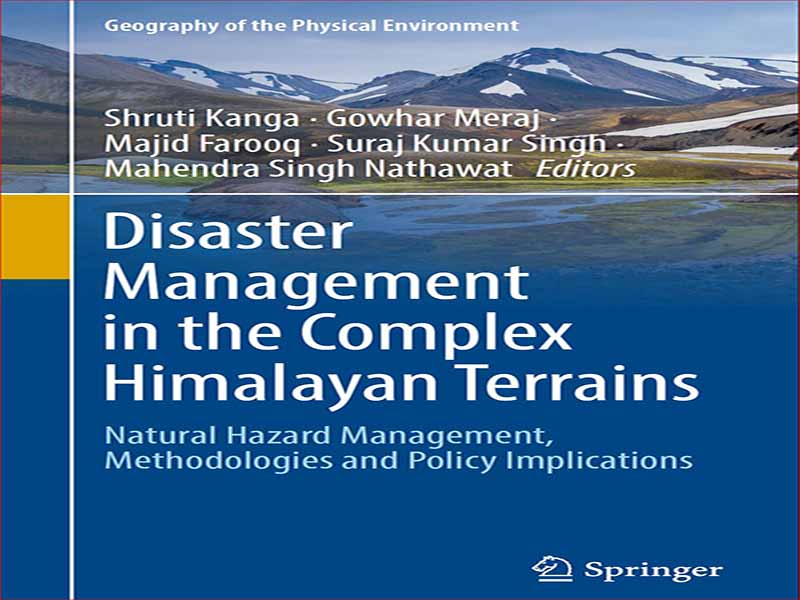- عنوان: Disaster Management in the Complex Himalayan Terrains
- نویسنده: Shruti Kanga
- حوزه: مدیریت بلایا
- سال انتشار: 2022
- تعداد صفحه: 186
- زبان اصلی: انگلیسی
- نوع فایل: pdf
- حجم فایل: 7.65 مگابایت
کتاب حاضر حاصل همکاری بین دانشگاه سورش گیان ویهار، جیپور، گروه اکولوژی، محیط زیست و سنجش از دور، دولت جامو و کشمیر، و گروه جغرافیا، دانشگاه آزاد ملی ایندیرا گاندی، دهلی نو، هند است در طول کنفرانس بین المللی تغییرات آب و هوا و تحقیقات آب 2020، دانشگاه سورش گیان ویهار، زمانی که ویراستاران در مورد عوامل انسانی افزایش دهنده خطر در منطقه هیمالیا به سمت خطرات طبیعی بحث کردند، از آن روز به بعد، ما تلاش و انگیزه زیادی انجام دادیم این کتاب در مورد انواع خطرات رایج در منطقه هیمالیا، تکامل، علم و کاهش آنها بحث می کند. در صورتی که سیاست ها توسعه و پایداری را با هم در نظر بگیرند، به درستی می توان گفت که خطرات در زمینه کاهش اثرات مخرب بر محیط زیست و تلفات جانی و مالی انسان ها قابل مدیریت هستند برای ارائه یک بحث جامع در مورد تکامل، کاهش، و آسیب پذیری در مواجهه با خطرات طبیعی، با تاکید بر نقش فناوری سنجش از راه دور این کتاب به طور جامع خطرات موجود در زمین هیمالیا را از طریق بررسی سیستماتیک ادبیات فعلی خطرات طبیعی مورد بحث قرار می دهد. به طور خاص، سیلابها در زمینهای ناهموار هیمالیا، پروژههای انرژی بسیاری را از بین بردهاند. یکی از مطالعات موردی کتاب ما بر روی این موضوع متمرکز شده است. GLOFs) با تمرکز ویژه بر نحوه مدلسازی و نقشهبرداری آنها در سپتامبر 2014، یکی از ویرانگرترین سیلابهای قرن را شاهد بود و تکامل نیز مورد بحث قرار گرفته است. زمین لغزش ها پدیده ای گسترده در هیمالیا هستند که به دلیل ساخت و سازهای بزرگراهی تشدید شده است انسانها میتوانند آنها را با اطمینان پیشبینی کنند، که باعث کاهش تلفات جانی در این مناطق میشود مذاکره در مورد آتش سوزی جنگل و جامو و کشمیر برای ارزیابی آسیب پذیری منطقه در برابر آتش، فصل خاصی به سنجش از دور و GIS برای ارزیابی خطرات طبیعی در هیمالیا اختصاص داده شده است در یکی از فصلهای مدیریت بلایا در زمینهای پیچیده هیمالیا بحث شده است: مدیریت مخاطرات طبیعی، روشها و پیامدهای خطمشی یک کتاب ویرایششده جامع با تمرکز بر مدیریت مخاطرات طبیعی با استفاده از تکنیکهای نوآورانه علوم اطلاعات مکانی و فصول سنجش از راه دور است نوشته شده توسط محققان و متخصصان برجسته در زمینه مدیریت خطر، سنجش از دور و GIS با تمرکز بر جبران شکاف موجود در ادبیات موجود در این زمینه با آوردن مفاهیم، تئوری ها و تجربیات عملی متخصصان و متخصصان در این زمینه. این کتاب با هم در یک جلد به دانشآموزان، محققان و سیاستگذاران کمک میکند تا درک کاملی از مدیریت و سیاستهای مخاطرات طبیعی در منطقه پیچیده هیمالیا ایجاد کنند یک جامعه دانشگاهی که به طور خاص بر روی کاهش و مدیریت مخاطرات طبیعی هیمالیا با استفاده از علوم فضایی و ابزارهای پیشرفته مدلسازی کار میکند. ما میخواهیم از کمک همه داورانی که خستگی ناپذیر فصلها را مطالعه کردند و پیشنهاداتی را برای نویسندگان ارسال کردند، قدردانی کنیم. با تشکر ویژه از دکتر NeeluGera، و دکتر Muzamil Amin، برای پیشنهادات ارزشمند خود را در طول تصحیح کتاب، مایلیم از خانواده های ما که در هر مرحله از ما حمایت کردند هیچ چیز بدون کمک و حمایت آنها ممکن نبود فصلهای بعدی، و تعدادی از اینها ممکن است شما را با سوالات بیشتری نسبت به پاسخ مواجه کند.
The present book is an outcome of the collaboration between Suresh Gyan Vihar University, Jaipur, Department of Ecology, Environment and Remote Sensing, Government of Jammu and Kashmir, and the Department of Geography, Indira Gandhi National Open University, New Delhi, India. The book was conceptualized during the International Conference on Climate Change and Water Research 2020, Suresh Gyan Vihar University, when the editors discussed anthropogenic factors augmenting the risk in the Himalayan region toward the natural hazards. From that day onward, we put a lot of effort and motivation into making this book become a reality. This book discusses different types of hazards prevalent in the Himalayan region, their evolution, science, and mitigation. The book has tried to collate all the significant natural hazards at one place discussing their genesis and how mitigation can be made effective if policies are designed considering the development and sustainability together. Under these paradigms, the hazards can be rightly said that they are manageable in the context of reducing the deleterious impacts on the environment and the loss of human life and property. This book aims to provide a comprehensive discussion on the evolution, mitigation, and vulnerability in the face of natural hazards, emphasizing the role of satellite remote sensing technology. The book comprehensively discusses the hazards in the Himalayan terrain’s perspective through a systematic review of the current literature. Natural hazards have always been regarded as the destroyer of economies. More specifically, the floods in the rugged Himalayan terrains have washed away numerous hydel power projects. One of the case studies of our book has focused on this issue. The role of Glacial Lake Outburst Floods (GLOFs) has also been described in detail, with a particular focus on how they can be modeled and mapped. In September 2014, Kashmir Valley, India’s northernmost region, witnessed one of the most devastating floods in the century. A particular focus on its genesis and evolution has also been discussed. Landslides are awidespread phenomenon in theHimalayas that has got aggravated due to highway constructions. Special chapters were dedicated to discussing them in detail. Moreover, earthquakes are part and parcel of people living in the Himalayas, and what if humans can forecast them with some certainty, that would reduce the loss of life in these regions. The forecasting of earthquakes has also been discussed in detail with some innovative techniques to make it happen. Further, we have also discussed the Government of India’s approach to tackling forest fire and Jammu and Kashmir’s case for assessing the region’s fire vulnerability. A special chapter has been dedicated to remote sensing and GIS for assessing the natural hazards in the Himalayas. Also, how policies can be used to mitigate the natural risks in the Himalayas have been discussed in one of the chapters. Disaster Management in the Complex Himalayan Terrains: Natural Hazard Management, Methodologies and Policy Implications is a comprehensive edited book focusing on managing natural hazards using innovative techniques of spatial information sciences and satellite remote sensing. Chapters have been written by eminent researchers and experts in the field of hazard management, remote sensing, and GIS with a focus to replenish the gap in the available literature on the subject by bringing the concepts, theories, and practical experiences of the specialists and professionals in this field together in one volume. The book shall help students, researchers, and policymakers develop a complete understanding of themanagement and policy implications of natural hazards in the complex Himalayan region. We hope that through this book project, the team of authors will become part of an academic community working specifically on the mitigation and management of the natural hazards on the Himalayas using spatial sciences and state of the art of modeling tools.We want to acknowledge the help of all the reviewers who tirelessly read chapters and sent suggestions to authors that greatly enhanced their quality and prospective reach. Special thanks are toDr. NeeluGera, Dr.MuhammadMuslim, and Dr. Muzamil Amin, for their valuable suggestions during the book’s proofreading. Finally,wewould like to thank our familieswho supported us in thick and thin at each stage of our lives; nothing would have been possible without their help and support. We hope you shall enjoy reading this book on the various perspectives of the natural disaster–human interference relationship. Unfortunately, there are almost certainly more approaches than we could include in the following chapters, and a number of these may leave you with more questions than answers.
این کتاب را میتوانید بصورت رایگان از لینک زیر دانلود نمایید.
Download: Disaster Management in the Complex Himalayan Terrains





































نظرات کاربران